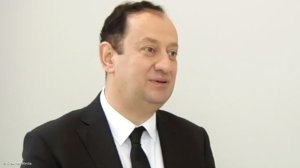CAPE TOWN (miningweekly.com) – Helping South Africa to return to being a producer of ferromanganese will be a major 2025 focus of mining company Menar, its MD Vuslat Bayoglu emphasised on Wednesday.
In an interview on day three of the Investing in African Mining Indaba 2025, Bayoglu spoke of being “very excited” about the prospect of his company being part of South Africa’s mining-linked re-industrialisation, through the revival of an asset that was once the world’s biggest ferromanganese producer. (Also watch attached Creamer Media video.)
Last year, Menar consummated a transaction with Samancor involving the acquisition of the South32/Anglo Joint Venture (JV) Metalloys ferromanganese asset in Meyerton, Gauteng.
“I have to give the credit to the South32/Anglo JV, which kept the asset in pristine condition,” Bayoglu noted.
Ahead of being placed on care and maintenance in 2020, Metalloys was the world’s largest ferromanganese producer and steps are now being taken restart it under the new name of Khwelamet.
“The idea is to prepare Khwelamet to be ready to be restarted, so this is going to be one of our important focuses this year,” Bayoglu enthused.
Menar’s revival plans are taking place amid South Africa being the world’s largest producer of manganese ore.
The property’s large slag dump from which ferroalloys can be recovered is also of considerable value.
Interestingly, two of the smelter’s four furnaces are only ten years old.
While talking to Eskom about power considerations for the restart of these furnaces, Menar is simultaneously studying options outside of electric arc furnace technology.
Under scrutiny, as well, is the blast furnace route, amid discussions with providers of technology that slashes two-thirds off the electricity required for existing smelting.
In addition, there is a 50 MW gas-fired power station on the property, which Menar could quickly start using if it could secure a supply of gas.
Entry into the battery grade manganese metal field through an unidentified “old” asset is also being contemplated.
On the Mining Indaba itself, Bayoglu said of the event, now in its thirty-first year: “It's very exciting to be here. It's great to see the enthusiasm.”
ANTHRACITE AND STEAM COAL
Regarding anthracite, Menar is planning to finalise the licensing of the Riversdale and Fuleni projects in KwaZulu-Natal, which are both viewed as being quality assets that have the potential to employ many people.
On the steam coal side, both Bekezela, near Springs, and Thuso, near Bethal, are licensed, with Bekezela set to be a flagship operation capable of producing at a rate of 7.2-million run-of-mine tons a year.
In planning to move the coal by rail, Menar would like to create its own rolling stock capacity as part of the new TRIM applications being accepted by Transnet.
“The other thing very critical for us is to look at the kind of JVs that we can create in South Africa with emerging South African companies.
“We’re targeting different commodities. We’re a very firm believer in investing in South Africa. Yes, we've got challenges with Eskom and Transnet, but I think current administrations of Transnet and Eskom are addressing those.”
Mining Weekly: How prepared do you think South Africa is to seize opportunities in the critical mineral space?
I think every mineral is critical in our lives. If you look at what is produced by South African miners in South Africa, chrome is a critical mineral. Manganese is a critical mineral. Platinum group metals are critical minerals. Iron-ore is critical. Coal is critical because it’s got applications that are very critical for us. If you don't have manganese, or if you don't have chrome, you can't make steel and stainless steel. To stop the pollution from vehicle exhausts, you need PGMs, which are critical for our economy. The current Eskom administration has stabilised the business and they now need to come up with the right plans for the future. The other aspect in terms of critical minerals is the role of Transnet. Without having stable movement of our bulk minerals to the different ports of South Africa, we don't have a business. The other thing important in being ready for what could be a critical minerals boom is the [mining] cadastral system. If rail, power and the cadastral system issues are addressed, there’ll be no obstacles in the way of South Africa being successful in critical minerals.
EMAIL THIS ARTICLE SAVE THIS ARTICLE ARTICLE ENQUIRY FEEDBACK
To subscribe email subscriptions@creamermedia.co.za or click here
To advertise email advertising@creamermedia.co.za or click here










